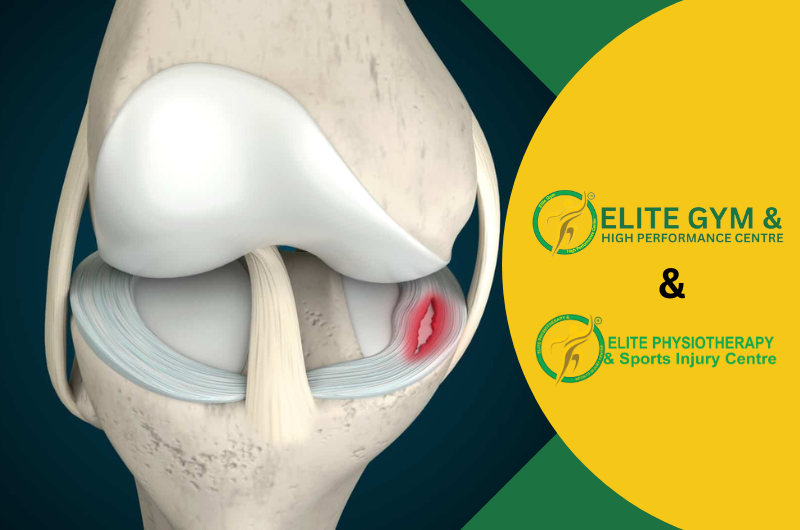Meniscus injuries are frequent among sportsmen and regular people equally. Injuries can have a substantial impact on mobility and quality of life, whether they are caused by sports or regular activities. Elite Physiotherapy and Sports Injury Centre specializes in the diagnosis, treatment, and rehabilitation of meniscus injuries, ensuring that each patient receives a personalized recovery plan.
What is the Meniscus?
In the knee joint, the meniscus is a crescent-shaped piece of cartilage placed between the femur (thigh bone) and the tibia (shin bone). Each knee contains two menisci: medial (inside) and lateral (outside). These structures operate as shock absorbers, cushioning and stabilizing the knee joint.
Causes of Meniscus Injuries
Meniscus injuries can arise for a variety of causes, which vary between athletes and the general population:
In Athletes:
Athletes that participate in contact sports such as football, rugby, basketball, or tennis are more likely to sustain meniscus injuries. The injury frequently happens when the knee is violently twisted or turned, or when an athlete lands awkwardly after a jump.
In General Population:
Non-athletes frequently sustain meniscus injuries from ordinary tasks like squatting, climbing stairs, or carrying heavy things. As we age, the meniscus becomes more prone to degeneration, increasing the risk of tears even with slight motions.
Symptoms of Meniscus Injury
A meniscus injury can result in a variety of symptoms, including:
- Pain in the knee joint, particularly while twisting or turning it.
- Swelling around the knee can arise suddenly or gradually.
- A sensation of the knee “locking” or being unable to completely extend.
- A feeling of instability or giving way in the knee joint.
- Squatting and knee bending are difficult actions.
- If you or someone you know suffers these symptoms, get professional help right once.
Diagnosis and Treatment at Elite Physiotherapy and Sports Injury Centre
Elite Physiotherapy and Sports Injury Centre takes a thorough approach to diagnosing and treating meniscus injuries:
Clinical Assessment:
Our trained physiotherapists undertake a complete assessment, including range-of-motion tests, palpation, and specific testing to precisely diagnose meniscus problems.
Imaging Techniques:
Imaging studies, such as MRI scans, may be recommended to confirm the diagnosis and determine the injury’s severity. This assists in devising the best effective treatment strategy.
Non-Surgical Treatment Options:
Non-surgical treatments can be successful for small meniscus tears or degenerative tears in older persons. Our therapy regimens often include the following:
Physiotherapy:
Physiotherapy involves tailored exercises to strengthen muscles surrounding the knee, improve flexibility, and restore normal movement patterns. Specific treatments, such as isometric exercises and progressive resistance training, are utilized to progressively restore knee function.
Manual Therapy:
Manual therapy involves mobilization techniques to improve knee joint mobility and relieve discomfort.
Electrotherapy:
Electrotherapy, including ultrasound, TENS, and laser therapy, can help decrease inflammation and facilitate healing.
Surgical Intervention and Post-Surgical Rehabilitation:
If the tear is severe or the knee joint remains unstable, surgery such as arthroscopic meniscectomy or meniscus repair may be required. Elite Physiotherapy and Sports Injury Centre collaborates closely with orthopedic doctors to offer a comprehensive approach to care.
Following surgery, our post-operative rehabilitation program seeks to restore strength, mobility, and functional movement patterns. This includes:
Progressive Loading Programs:
Progressive Loading Programs aim to gradually increase knee load-bearing capacity and strength.
Balance and Proprioception Exercises:
Balance and proprioception exercises involve using balance boards and stability training to improve knee control and avoid future injuries.
Sport-Specific Rehabilitation:
We use sport-specific drills and routines to help players safely and effectively return to their sport.
Prevention Tips
To avoid meniscus problems, strengthen the muscles around the knee while also increasing flexibility and balance. Here are some practical suggestions:
Warm-Up Properly:
Warm-Up Always warm up before starting in physical activities. Dynamic stretching and mobility exercises can help to prepare muscles and joints for movement.
Strength Training:
Incorporate strength workouts for the quadriceps, hamstrings, and calf muscles. These muscles support the knee and preserve the meniscus.
Balance Training:
Balance training enhances knee stability, lowering the risk of damage during unexpected movements.
Avoid Sudden Movements:
Be wary of unexpected twisting or pivoting motions, especially on uneven ground.
Elite Physiotherapy and Sports Injury Centre: Your Partner in Recovery
Whether you are a person seeking to resume your regular routine without experiencing any pain or an athlete hoping to return to peak performance, we at Elite Physiotherapy and Sports Injury Centre understand the impact a meniscus injury can have on your life. Every patient is guaranteed to receive the finest care possible thanks to our individualized, evidence-based treatment regimens.
Do not hesitate to contact us if you have knee pain or suspect a meniscus tear. Our staff is committed to assisting you with regaining your strength, mobility, and self-assurance when moving.
This is where your path to recovery begins. Every step forward matters when you visit Elite Physiotherapy and Sports Injury Centre.

